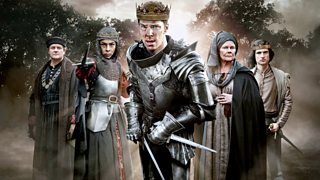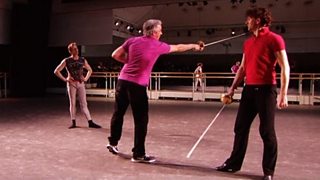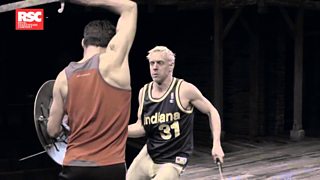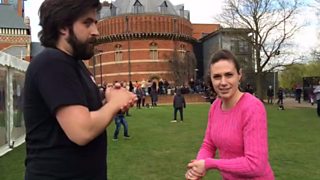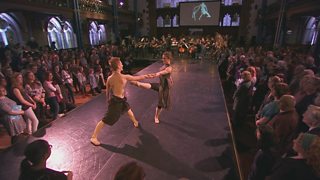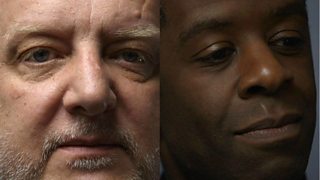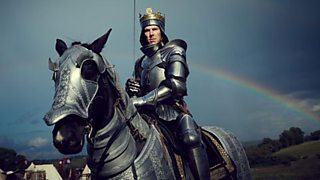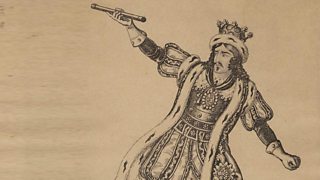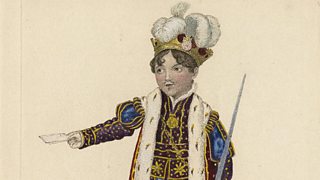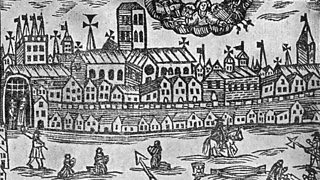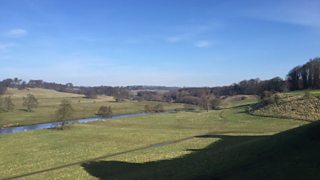Bigger, Bolder, Bloodier - Pick your Battles with The Hollow Crown
It’s the big set-piece battles which help give The Hollow Crown its authenticity. You can almost smell the tired and wet actors, heavy armour and blood-spattered fields...
These are all in a day's work for Stunt Co-ordinator Andreas Petrides. We caught up with him to find out more about the background to the battle scenes and how he got into this line of work.
Meet the Cast
-
![]()
The leading men and women of The Hollow Crown: The Wars of the Roses, share their experiences.
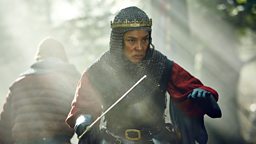
Working on stunts and battle scenes must be hard work for the actors - do they complain?
Artists are often surprised at how heavy the armour and weapons can be.
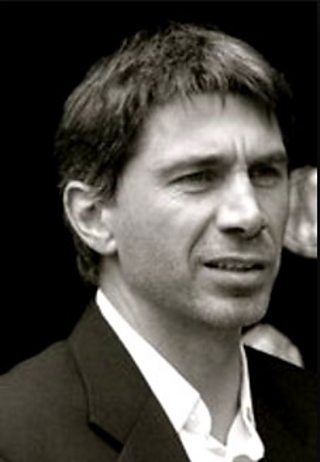
think what it was like for the real warriors! with no trailers and tea on standby!
When they get tired and drained during battle scenes, I always say "think what it was like for the real warriors! with no trailers and tea on standby!"
When actors ask "why do we have to do another take?” I always say "Because you can do it better, can't you !" – and they always agree!
How did you battle time pressures?
Teaching fight routines and moves to actors takes time. I have to get them looking like battle-hardened, experienced warriors in a sometimes a very short amount of time, so the pressure can be tough on the artists and myself.
Benedict and Luke [Treadaway] have a theatre background where they’ve learned stage combat.
Screen combat’s a little different. We need to make everything work for the camera. We need to work on that realism. The energy and aggression to make it work for the camera.
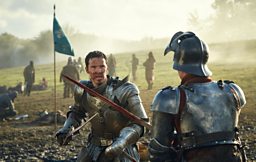
How do you train the artists?
I break the training down to 3 phases:
1: Teach the fight movements and techniques
2: Demonstrate and teach the fight routine
3: Work with the artists on the character style and realism
Routines and moves for the actors take time and we don’t have a great deal of time filming, so it’s been very full on. The actors have to learn the moves they’re going to do, then they have to learn the dance, then perfect it and make it look real.
The Alnwick Fight Team

in cold, raining weather, up to your knees in mud and waist height in rivers!
The fights and battle training was extremely full-on - in cold, raining weather, up to your knees in mud and waist height in rivers! It can be exhausting for everyone involved, from the main actors and stunt performers through to skilled supporting artists.
How does the live action work alongside CGI?
A lot of the scenes will have CGI arrows. A line of soldiers runs towards another line of soldiers, firing crossbows. They will release the mechanism but there will be no arrow or bolt in the weapon, and the CGI will make them hit the guys on the other side, and they will fall and react.
"A horse! A horse!..."
Horses are unpredictable and do their own thing! They’re working in close proximity to a lot of extras and a lot of artists. With a horse fall, it’s simulating that it has been hit by an arrow. The arrow going into the horse is done by CGI. The rider, who is trained, will ride the horse over and land it on a bed that has been dug out and set in a pre-set area.
How many actors make up a battle stunt?
This can vary dramatically, dependent on budget, time-scale and requirements, but on The Hollow Crown: War of the Roses we had 10 - 12 principle actors fighting at once during the main battle clash sequences, about 20 stunt performers and over 100 skilled supporting artists.
Organising and designing the battles with this many people was challenging, but using real people instead of CGI effects always makes battle sequences more realistic.
You get a sense of satisfaction when you watch back rushes and see that it all works because the entire department has put their time in. My side is making the action look real and authentic, with minimal accidents, because accidents can happen. If everyone is trained and knows what they’re doing, we can control that. It’s great to go home with no injuries – perfect.
I didn't have the luxury of weeks /months of rehearsal time
Unlike feature films, I didn't have the luxury of weeks /months of rehearsal time. That's why it was imperative that we had teams of stunt performers and skilled supporting artists who are trained in screen combat. Having all been trained in the British Action Academy's Warrior Masterclass screen combat course, it prepares performers in how to fight for screen. Having an entire battlefield with trained artists is a blessing for stunt co-ordinators and a necessity for Production. It minimises training/rehearsal time and Production have the guarantee of performers who are safe and competent in their action.
Bloody battles?!
I don’t know how many pints of (fake) blood were spilled, but the SFX team were there all the time with blood guns spraying constantly in between takes. They were also busy filling the battlefield with limbs and decapitated heads. Even though the blood and limbs are fake, they can look terrifyingly real!
Even though the blood and limbs are fake, they can look terrifyingly real!
We use lightweight materials for weapons and armour so they are lighter than the real armour and weapons these warriors used to wear. That being said, the armour can still be heavy and cumbersome and the weapons can still weigh a lot and can cause damage! You can easily lose a finger get your head split open with prop weapons, that's why using trained performers and having rehearsals is essential!
Upping the ante for The Wars of the Roses...
I think the main thing for me in creating the action for the battle sequences on the Hollow Crown II was the limited time I had for rehearsals and to train the actors. As I had worked on the earlier Hollow Crown series, I knew that the Producers wanted the action to be bigger and better than before, which was achieved!
What was your biggest challenge on The Hollow Crown: The Wars of the Roses?
The most difficult sequence to set up was the battle clash in the wood for the Tewkesbury battle. We needed to have most of the fighting cast seen and involved, with around 20 stunt performers, 20-30 horses, 100 skilled supporting artists and lots of camera crew, running at each other on two sides and clashing in the middle in a very small enclosed wooded area. Scenes like that take a lot of planning and preparation to ensure no one gets hurt.
We sometimes shot full on for up to 5 minutes a take so it can get exhausting for everyone involved! Those scenes are challenging but, for me, the best part of my job!
Andreas's Battle Numbers
26: years experience working in stunt co-ordination
4: number of months before shooting began, when Andrea first met with director and producer to discuss requirements
10-12: principle actors to work with
20: stunt performers
100: skilled supporting artists
30: horses
10-12: daily hours on set during battle scenes - when shooting the river battle, time in the water was minimised. Artists wore setsuits, but prolongued periods in water could lead to hypothermia, so warm breaks were factored in.
??: pints of (fake) blood sprayed on set - we don't have a number but there was a lot, courtesy of the SFX team (who also provided frighteningly realistic dismembered heads and limbs!)
80: weight in lbs of armour (actors' outfits were rather lighter)
15: weight in lbs of a real longsword
Multiple camera crews - in the thick of the action. Safety is paramount so the action is all rehearsed with the camera teams.
0: injuries, thanks to the high level of training (just a few bruised and wracked knuckles!).
Experience is half the battle - Andreas Petrides
I have played numerous warriors through history including Spartans, Romans, Vikings, Musketeers, Ninjas, to Modern Soldiers. I have also trained and stunt doubled numerous artists in roles including Ewan McGregor as Obi Wan in Star Wars EP 1 and Joaquin Phoenix as Commodus in Gladiator.
I've been a member of the JISC Stunt Register for 26 years. To join you have to be county/ competitive level in six sporting disciplines such as: Gymnastics, Trampolining, Sub Aqua, Motorcycle/ Car racing, Climbing, Horse riding and Martial artists to name a few.
I always wanted to do stunts ever since I can remember and I did many years of stunt performing before I Stunt Co-ordinated or Fight Arranged.
I had a passion for numerous sports and the stunt industry has allowed me to utilise my skills in many areas of the business including: falling from high buildings, being set on fire, turning over cars or crashing motorcycles! as well as battling as historical warriors with weapons!
With the fighting side of the industry, I have always had a passion for the Martial Arts and Weaponry from a very young age and I have had the privilege to work with and learn from some of the best in the world.
No matter how old, you never stop learning in this business!
I was fortunate, together with a colleague, to design the opening sequence on Gladiator, where we had around 1,000 fighting men on the battlefield. We had months of preparation time as we had to make it epic. Luckily, all the hard work paid off and the film won multiple Oscars.
I recently created the three battle sequences for 1066, which had its challenges but was a great battle to do!
I will leave you with the words of the great Hollywood Stuntman Dar Robinson which rings true to me!
"Why grow up when you can make movies?"
Andreas the Stunt Actor - serious and comic!
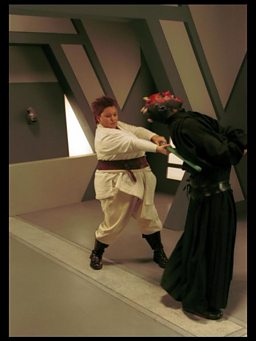
Benedict Cumberbatch on the battle scenes...
What was it like to recreate the medieval battles?
We were carrying around weapons of steel and aluminium, which were props but could still do a great deal of damage. We were fighting in fields and in rivers with water literally up to our chests. It was brutal.
The broadsword as a weapon could crack your skull open with just a glancing blow. It really is such a barbarous way to go about winning power. I’m in awe of it. The training was tough... All of us would come away from training looking shell-shocked and pale!

Director Dominic Cooke on the Battle Scenes
We used our resources to tell the story in a creative way. We have six battles so we wanted each one to look different. St Alban’s is a skirmish in a town, which is as it was historically.
We have a battle in fog, by a river, in a forest. The final battle, the Battle of Bosworth, is the most traditional. I make sure that each battle tells a story about our characters.
Towton culminates in Henry’s psychological breakdown, so everything is shot and edited from his point of view.
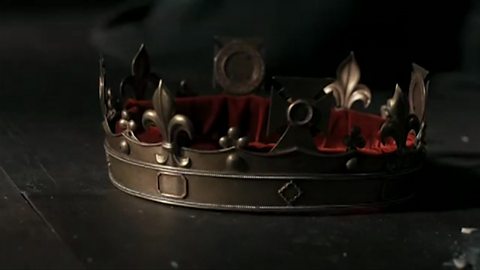
The Hollow Crown: Shakespeare's relevance 400 years on
What Shakespeare can tell us today about power and leadership
Stage Fighting
-
![]()
Romeo and Juliet sword-fighting rehearsal
-
![]()
Henry IV stage fighting at the Royal Shakespeare Company
-
![]()
Sword-fighting rehearsal at the Globe
Shakespeare Lives - Highlight Clips
-
![]()
A demonstration of the hair pulling technique used in stage combat.
-
![]()
An extract from the performance of Robert Allan's Three Love Songs, part of the Dream On! concert at the University of Glasgow's Bute Hall.
-
![]()
Simon Russell Beale and Adrian Lester discuss perhaps Shakespeare's most famous soliloquy
Shakespeare on Tour: Around the country
-
![]()
Deep inside the vaults of the British Library are stored thousands of theatre playbills.
-
![]()
Edmund Kean was the Laurence Olivier of his day. His appearance in Tewkesbury is a major coup for the town… and don’t they know it!
-
![]()
King Richard III's horse White Surrey is the star of the show.
-
![]()
The big draw was just 12-years-old and this pre-Victorian audience was about to see the child star take on Shakespeare's meatiest roles.
-
![]()
The first of Shakespeare’s plays to be performed in Kent was probably Henry VI Part 1.
-
![]()
Alnwick Castle provides the backdrop for the new Hollow Crown series
